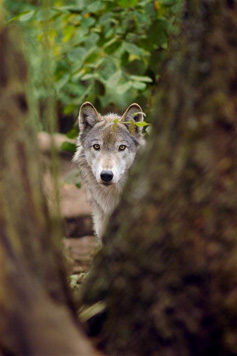Wolves of North America
There are three species of wolves found in North America—the Gray Wolf, the Eastern Wolf, and the Red Wolf.
Gray Wolf
Canis lupus
Description: The largest member of the wild dog family, Gray Wolves weigh on average 60–120 pounds and can have a variety of fur colors which differ between subspecies and include gray, black, and white.
Range: In North America today, Gray Wolves can be found in Alaska, Canada, and some northern U.S. states. Gray wolves also inhabit Russia and some other European countries.
Prey: Elk, deer, moose, caribou sheep, bison and occasionally other animals like rodents, fish, and birds.
Pack: Wolves are extremely social animals that live in hierarchical groups called "packs" of 2–12 members, including adults, subadults, and pups. Usually, the two dominant adults, the breeding male and female, are the only ones in the pack that mate. Living in packs has three main advantages for wolves: they can collectively help each other take down big prey, defend the pack's territories, and help raise the pups.
There are five subspecies of Gray Wolves recognized in North America. The most endangered of these is the Mexican Gray Wolf.
Eastern Timber Wolves
Canis lupus lycaon
Range: Southern Canada and the northeastern United States
Red Wolf
Canis rufus
Appearance: Red wolves are larger than coyotes but smaller than Gray Wolves and weigh 45–80 pounds. They have reddish fur that runs along their ears, neck and legs. The rest of their fur is mostly brown or buff colored.
Range: Once common throughout the southeastern United States, Red Wolves became extinct in the wild, but have been reintroduced to North Carolina as part of a Species Survival Plan. They now inhabit five counties in the northeast of the state.
Prey: Raccoons, rabbits, white-tailed deer, nutria, and other rodents.
Pack: Red Wolf pack sizes tend to be smaller than Gray Wolves, and because they take smaller prey, they often hunt alone or in pairs.
Great Plains Wolves
Canis lupus nubilus
Range: Studies suggest wolves from Minnesota, Wisconsin, and upper Michigan are descendants of this subspecies. Great Plains Wolves once had the largest range of any North American subspecies and inhabited most of the western United States, and central and southeastern Canada.
Prey: Raccoons, rabbits, white-tailed deer, nutria, and other rodents.
Mexican Gray Wolves
Canis lupus baileyi
Range: Mexican Gray Wolves once inhabited Mexico and parts of the southwestern United States. As of 2010, there were 42 free-ranging Mexican Gray Wolves in the Apache and Gila National Forests in Arizona and New Mexico.
Note: The Mexican Gray Wolf is one of the rarest mammals in the world.
Alaskan and Rocky Mountain Wolves
Canis lupus occidentalis
Range: Most of Alaska and Canadian and northern U.S. Rocky Mountains.
Arctic Wolves
Canis lupus arctos
Range: The Arctic region of North America.


